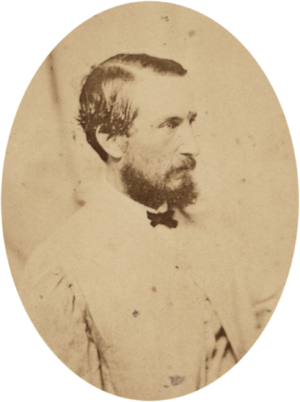Henry O'Farrell facts for kids
Quick facts for kids
Henry James O'Farrell
|
|
|---|---|

Henry James O'Farrell, Sydney, 1868, by Montagu Scott
|
|
| Born | 1833 Arran Quay, Dublin, Ireland
|
| Died | 21 April 1868 Darlinghurst Gaol, Sydney, Australia
|
| Occupation | Produce merchant |
| Criminal status | Executed |
| Conviction(s) | Attempted murder of Prince Alfred |
| Criminal penalty | Death |
Henry James O'Farrell (1833–21 April 1868) was the first person to try a political assassination in Australia. On 12 March 1868, he shot and injured Prince Alfred, Duke of Edinburgh. Prince Alfred was the second son of Queen Victoria.
Contents
Who Was Henry James O'Farrell?
Henry James O'Farrell was born in Arran Quay, Dublin, Ireland, in 1833. He was the youngest child of William O'Farrell, who was a butcher. His family later moved to Liverpool in England. After that, they traveled to Victoria, Australia.
O'Farrell worked for a short time for his brother. His brother was a lawyer in Melbourne. O'Farrell's most recent job was selling fruits and vegetables. He worked in the Haymarket area of Ballarat.
The Attack on Prince Alfred
In 1868, Prince Alfred was 23 years old. He was on a trip around the world. This trip included the first royal visit to Australia. He planned to visit many cities, including Adelaide, Melbourne, Brisbane, and Sydney.
On 12 March, the Prince was at a Sailor's Picnic. This event took place in Clontarf, New South Wales, a suburb by the harbor. O'Farrell, who was 35 at the time, approached the Prince. He then fired a gun into the Prince's back.
A local coach-maker named William Vial quickly stopped O'Farrell. Vial was later given the Prince's special watch for his brave actions. Vial and other people nearby quickly held O'Farrell down. The crowd was very angry about the attack. They beat O'Farrell badly. Police arrived and took him away to safety.
The Prince was shot in his back, near his spine. The injury was serious, but he survived. The Prince stayed in the hospital for two weeks. Six nurses cared for him. These nurses were trained by Florence Nightingale. They had just arrived in Australia that February.
Public Reaction and Trial
The attack caused great shock in the colony. It led to strong feelings against Catholic and Irish people. This anger was directed at all Irish people, even those who supported the British. The next day, 20,000 people gathered. They protested the "outrage" that had happened.
O'Farrell first claimed he was working for the Fenian Brotherhood. This was a group that wanted Ireland to be free from British rule. He later said this was not true. He denied being a Fenian, even though he was against the British and the Royal Family.
O'Farrell's trial took place in Sydney on 30 March 1868. His lawyer was Butler Cole Aspinall. Aspinall had defended other famous people in the past. He tried to argue that O'Farrell was not guilty because of mental illness. He mentioned O'Farrell's history of mental health issues. He also said O'Farrell had recently left a mental hospital.
However, O'Farrell was found guilty. Judge Alfred Cheeke sentenced him to death. Prince Alfred himself tried to help O'Farrell. He asked for O'Farrell's life to be saved, but he was not successful. O'Farrell was hanged on 21 April 1868. He was 35 years old. This happened at the Darlinghurst Gaol.
Prince Alfred's Recovery and Memorial
Prince Alfred got better quickly after the attack. He returned home in early April 1868. On 24 March, the New South Wales Legislative Assembly decided to build something special. They wanted to create a lasting monument. This monument would show how grateful people were for the Prince's recovery.
This special building was to be the Prince Alfred Hospital. Queen Victoria allowed it to be called "Royal." So, it became the Royal Prince Alfred Hospital. Money for the hospital was raised by public donations. Today, it is a very important hospital in New South Wales.
Henry Parkes was a government minister at the time. He later became the Premier of New South Wales. After O'Farrell's attack, Parkes tried to stir up anger against Irish Catholics. Parkes claimed that O'Farrell's first statements about being a Fenian were true. He said there were many Fenian plots happening.
When a Canadian politician, D'Arcy McGee, was killed by a Fenian on 7 April, the excitement grew. But soon, the public started to calm down. They began to question Parkes' claims, which had no proof. These claims became embarrassing for Parkes. He resigned from his minister position in September.

